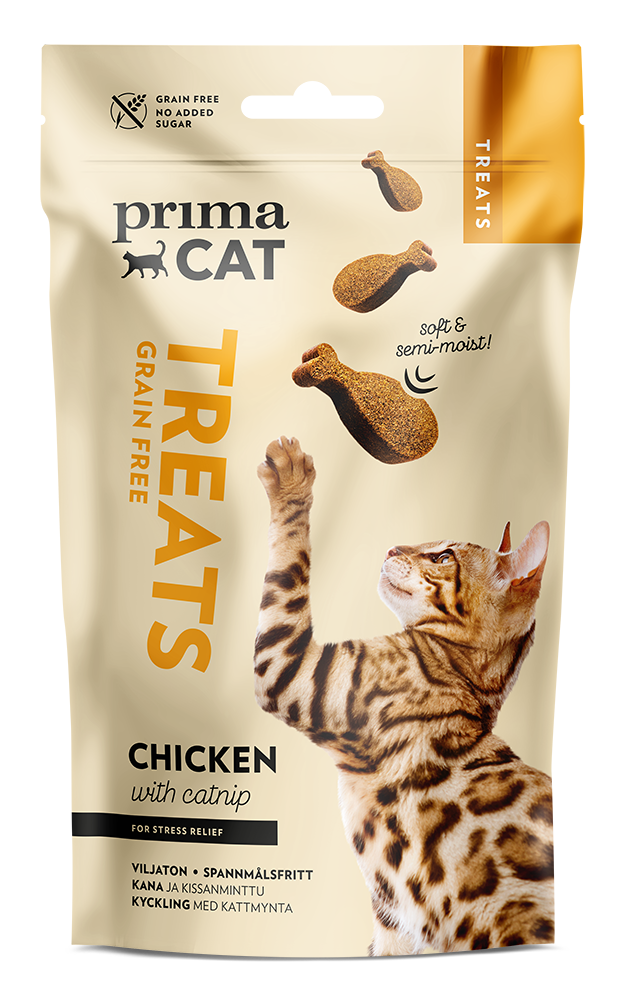
The Purrfect Duo: Why Chicken and Catnip Cat Treats Are a Hit with Felines
Cats. They’re enigmatic, independent, and utterly adorable. As devoted cat parents, we’re always on the lookout for ways to enrich their lives, whether through playful toys, cozy beds, or, most importantly, delicious and nutritious treats. Among the myriad of options available, chicken and catnip cat treats have emerged as a clear favorite, and for good reason. They offer a tantalizing combination that caters to a cat’s natural instincts and desires.
The Allure of Chicken: A Protein Powerhouse
Chicken, a staple in many cat foods, is a highly palatable and beneficial ingredient for our feline companions. Here’s why it holds such appeal:
-
Rich in Protein: Cats are obligate carnivores, meaning their bodies are designed to thrive on a diet primarily composed of animal protein. Chicken is an excellent source of high-quality protein, essential for building and repairing tissues, supporting muscle development, and maintaining a healthy immune system.
-
Essential Amino Acids: Chicken contains all the essential amino acids that cats need but cannot produce on their own. These amino acids are vital for various bodily functions, including energy production, hormone synthesis, and enzyme activity.
-
Highly Digestible: Chicken is generally easy for cats to digest, making it a suitable option for cats with sensitive stomachs or digestive issues.
-
Palatability: Let’s face it, most cats simply love the taste of chicken. Its savory flavor and aroma are highly enticing, making it an ideal ingredient for treats that cats will eagerly devour.
Catnip: The Herb That Makes Cats Go Wild
Catnip, scientifically known as Nepeta cataria, is a member of the mint family that contains a chemical compound called nepetalactone. This compound is responsible for the euphoric and often hilarious reactions that many cats exhibit when exposed to it.
-
How Catnip Works: When a cat sniffs catnip, nepetalactone binds to receptors in their nasal cavity, stimulating sensory neurons that lead to the brain. This triggers a cascade of neurological responses, resulting in temporary behavioral changes.
-
Common Reactions: The effects of catnip can vary from cat to cat, but common reactions include:
- Playfulness: Increased activity, running, jumping, and rolling around.
- Euphoria: A sense of happiness and contentment, often accompanied by purring and drooling.
- Relaxation: Some cats become mellow and calm, exhibiting a more relaxed demeanor.
- Vocalization: Increased meowing, chirping, or other vocalizations.
-
Not All Cats Respond: It’s worth noting that not all cats are affected by catnip. The response to catnip is hereditary, and it typically doesn’t affect kittens under six months of age. Studies suggest that around 70-80% of cats are susceptible to catnip’s effects.
-
Safe and Non-Addictive: Catnip is considered safe for cats and is not addictive. The effects usually last for about 5-15 minutes, after which the cat becomes temporarily immune to its effects for a couple of hours.
The Synergy of Chicken and Catnip
Combining chicken and catnip in cat treats creates a winning formula that appeals to multiple senses and instincts:
-
Flavor and Aroma: The savory taste of chicken combined with the aromatic scent of catnip creates a sensory experience that cats find irresistible.
-
Nutritional Value: Chicken provides essential protein and amino acids, while catnip adds a touch of fun and stimulation.
-
Enrichment: These treats offer mental and physical enrichment, providing a source of entertainment and engagement for cats.
-
Training and Bonding: Chicken and catnip treats can be used as positive reinforcement during training sessions, helping to strengthen the bond between you and your cat.
Choosing the Right Chicken and Catnip Cat Treats
With so many options available, it’s essential to choose high-quality treats that are safe and beneficial for your cat:
-
Read the Ingredient List: Look for treats that list chicken as the primary ingredient and avoid those with artificial colors, flavors, or preservatives.
-
Check the Nutritional Information: Ensure the treats provide a good balance of protein, fat, and carbohydrates.
-
Consider the Texture: Treats come in various textures, such as crunchy, soft, or chewy. Choose a texture that your cat enjoys and that is appropriate for their dental health.
-
Look for Reputable Brands: Opt for well-known and trusted brands that have a reputation for producing high-quality pet products.
-
Check for Added Benefits: Some treats may contain additional ingredients that offer specific health benefits, such as dental care or digestive support.
DIY Chicken and Catnip Treats
For the ultimate personal touch, consider making your own chicken and catnip cat treats at home. Here’s a simple recipe:
Ingredients:
- 1 cup cooked chicken, shredded
- 1/4 cup oat flour (or other cat-safe flour)
- 1 tablespoon dried catnip
- 1 egg
Instructions:
- Preheat your oven to 350°F (175°C).
- In a bowl, combine the shredded chicken, oat flour, catnip, and egg.
- Mix well until a dough forms.
- Roll out the dough on a lightly floured surface and cut into small shapes using a cookie cutter or knife.
- Place the treats on a baking sheet lined with parchment paper.
- Bake for 15-20 minutes, or until golden brown.
- Let the treats cool completely before serving.
Important Considerations:
-
Moderation is Key: Treats should only make up a small portion of your cat’s daily diet. Overfeeding can lead to weight gain and other health problems.
-
Allergies and Sensitivities: Be aware of any potential allergies or sensitivities your cat may have before introducing new treats.
-
Consult Your Veterinarian: If you have any concerns about your cat’s diet or health, consult with your veterinarian.
In Conclusion
Chicken and catnip cat treats offer a delightful combination of flavor, nutrition, and entertainment for our feline friends. By choosing high-quality treats and offering them in moderation, you can provide your cat with a tasty and enriching experience that strengthens your bond and promotes their overall well-being. So go ahead, treat your kitty to the purrfect duo – they’ll thank you for it!

